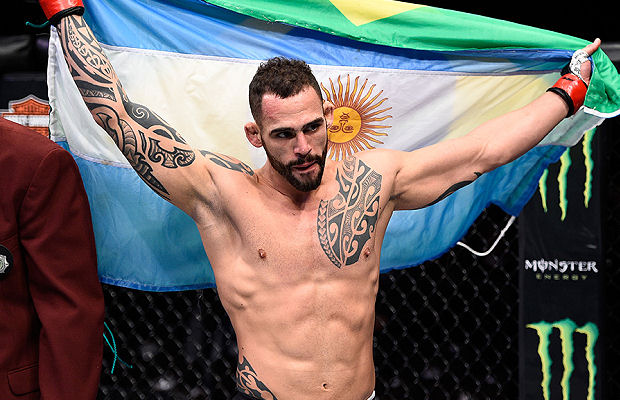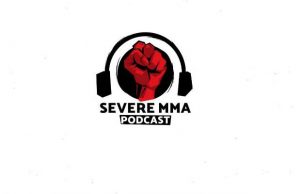

In part one of this two part series we discussed the things Gunnar Nelson could do to increase his opportunities to have prolonged success and to eventually gain a victory over the hard charging and offensively minded Santiago Ponzinibbio.
In part two I subscribe to the idea that turnabout is fair play and I give Santiago advice in regards to what he is facing and what he needs to do to have prolonged success versus the highly touted and ranked Gunnar “Gunni” Nelson.
Before I can give any reasonable advice on the path Santiago should take to achieve victory, I must first breakdown who and what he is facing in regards to athletic ability, technical ability and awareness and to make it clear WHY Nelson is a danger to halt the winning streak of Ponzinibbio.
Unlike Santiago, Gunnar is actually quite gifted athletically. He is quick, mobile, agile, balanced and explosive in regards to his ability to do damage, as well as close distances. On top of that is his borderline superhuman sense of timing, spatial awareness and rhythm. It is yet another layer of depth to his talent that further separates him from the majority of the inhabitants of this division, which while still competitive, has aged and to some degree plateaued.
In a division such as this Nelson’s hand and footspeed is off the charts when compared to the rest of the division, including the elite welterweights. This dynamic athleticism allows him a greater margin for error on the feet and allows him to go from effective to downright unstoppable on the ground. He is clearly one of the very best grapplers in the game, that skill is even more pronounced when you factor in the fact he can out athlete about eighty five percent of the division. His striking isn’t particularly deep or diverse but once again his top end physical ability allows him to make the most of the very limited but efficient skillset he has in that realm.
Speaking of his striking, Nelson’s game could best be described as classically unorthodox in the sense that he hasn’t followed the typical approach to striking in mixed martial arts, largely eschewing the principles, techniques and philosophies of the holy trinity of striking in MMA (boxing, muay thai and kickboxing).
Instead the Goju Ryu black belt relies on his previous Karate background as the foundation upon which he bases his striking game. What makes it unorthodox is the fact that very few fighters apply these specific techniques and/or strategies in the context of a mixed martial arts fight.
“Gunni” likes to work at range bouncing on his toes setting an awkward rhythm, pace and timing that limit his opponent’s ability to effectively take the initiative with actual striking technique, takedown attempts or forward pressure. This allows him to pick his spots in regards to his offensive maneuvers, he uses nifty angles to gain clean entries, which allow him to navigate distance and his opponents leads or counters long enough to blitz opponents (occasionally) or score singular/short burst offense (mostly).
Key weapons are his straight right, much like Lyoto Machida, Nelson likes to hypnotize his opponents with his bouncing, then explode in with his sharp right hand. Another favored tool is his lead leg which he uses to throw sidekicks, round kicks to the head body and legs. This minimalist approach limits the opportunity opponents have to apply damage to him, and it takes full advantage of his accuracy, speed and power by focusing on efficiency and execution more so than volume or aggression to control, back up or stop opponents. His stance is key in this, it allows him to explode forward and backwards and the low guard makes it difficult to track, time, defend and counter his punches.
Transitions are an area “Gunni” has really refined in his run in the Ultimate Fighting Championship. At earlier stages of his career he had a clear line of demarcation between his striking and his grappling which didn’t hinder him early, but clearly created some problems as guys got more tape on him and his level of opposition increased.
Recently Nelson has greatly improved his ability to mask his takedown attempts, which is especially important given his limited to nonexistent wrestling pedigree and the extended defense he likes to work from. He has always been able to hit reactive takedowns, as fighters would seek to close distance to get in position to pressure him, so he routinely is able change levels and catches them as they transition into striking range.
Now Nelson has learned to use his own offense to create takedowns, blitzing his opposition with well-timed strikes that put them in a defensive posture, allowing him to change levels for shots or to get into clinches and work an effective inside/outside trip game.
The final and most dominant phase Nelson works is the grappling phase. As mentioned earlier his efficiency in this area is only heightened by his elite level athleticism, particularly his agility, explosiveness and quickness. These things maximize his world class grappling, particularly his ability to get top control and suffocate an opponent from that position or to create avenues to pass into dominant positions for submissions, as well as transition from defensive or neutral positions into offensive ones where his timely and efficient ground and pound as well as his submission game can quickly turn and end fights.
The former ADCC competitor is one of the finest offensive grapplers in the game and as his loss to Demian Maia showed he is also one of the finest defensive and counter grapplers competing in mixed martial arts.
So now that we have taken a look at the technical and physical tools that determine Nelson’s approach to fights and execution in them, it’s time to discuss how Ponzinibbio can stop Gunnar from executing his game plan.
4) Leg kicks – The most obvious line to victory are the leg kick. Regardless of the level of striker or fighter Nelson has faced, the leg kick (inside or out) has been effective. This is largely due to his stance which enables him to close and extend distances very effectively but leaves him very vulnerable to leg kicks when exiting and especially when hanging out at mid-range (which is a bad habit of Nelson’s).
Gunnar doesn’t really check kicks and doesn’t generate the volume necessary to limit them, nor does his footwork enable him to limit the usage of them. Rick Story destroyed his legs with kicks and before being finished Alan Jouban was racking up points and damage with them. If a sustained leg kick attack can be established Nelson’s explosiveness, movement and ability to counter will all be compromised as he lacks the boxing skills to fight effectively in the pocket or the muay thai to work for extended periods in the clinch.

5) Volume – Nelson in his attempt to find the perfect shot and to get in without taking damage, will wait and regardless of how efficient and/or accurate he is, he isn’t a one shot one kill type hitter. Meaning that he can be outworked, even if Santiago isn’t landing, the sheer volume of offense can essentially take away his ability to manipulate distance, overshadow the cleanness of his shots, and exploit the holes in his standup game (i.e. head movement, upper body movement, etc.). Also a lot of volume (and variety of strikes) forces a pace Nelson and his standup isn’t suited for, draining his gas tank and allowing you to chip away at him and his resolve.
3) Take him down – I understand Santiago is facing one of the most athletic and skilled grapplers in mixed martial arts, I also understand you cannot concede any range or phase completely to an opponent, once that is done you have given them one less thing to worry about while you have to counter, defend and attack them at every level.
Takedowns, especially timely ones, allow Santiago to score points, further disrupt Nelson’s timing and rhythm, make him more cautious on the feet and open more lanes up for his standup.
Obviously you must be cautious, but if done in the right spots against the fence, times (end of rounds) and with the right intent (to get in close to strike or to score points and escape if things get dangerous). Then it becomes an effective tool that assists Santiago in every other phase of the fight.
2) Counter/Punch with Nelson – Nelson rhythm and timing is initially hard to figure out so guys holster their guns trying to catch on to his timing, essentially letting him build leads or find a rhythm which allows him to build momentum and either finish or dominate the length of the fight. Santiago, needs to stay in the pocket off of his offensive bursts and punch with “Gunni” as his lack of head movement and boxing acumen tees Gunnar up to be caught on the way in and out of boxing range.
Also when/if Gunnar lands, Ponzinibbio need to counter the counter and do so with volume, which will force Nelson out of his preferred pace, increase his chances of landing by throwing more and being able to pressure Nelson forcing him on the defensive, possibly sticking him on the fence and being in a position to overwhelm him or take him down. He also needs to throw a variety of strikes, being predictable in techniques and combos will get him hurt if not stopped.
1) Jab – The jab will set up the offense for Ponzinibbio, allowing him to establish a rhythm and gauge distance instead of crashing head first into Nelson’s offense/counters by using volume and aggression recklessly. It also acts as a line of defense, keeping “Gunni” unable to close distance with impunity for fear of running into the jab, which can trap him in the middle range where he is vulnerable and make him even more hesitant to attack or counter.
The jab also can act as a conductor, directing where, when and what intensity Gunnar can move, attack or counter. By having Santiago jab up and down his body, jabbing actively and feinting he can make Nelson move more than wanted, while not allowing him to move in an effective or efficient manner in regards to creating opportunities for strikes and takedowns.
These are not guarantees for success, but they are paths that can lead to victory and need to be at least considered in this matchup, Nelson is the far superior athlete and has faced the better caliber of athlete and fighter in the octagon and on top of that he is a far better grappler.
This is his fight to lose, Santiago does have a striking advantage in regards to the variety of strikes, the volume of strikes and the ranges he is effective in, but he is hittable, has been stopped before and has definitely shown problems dealing with a certain caliber of opposition and a certain level of athleticism. Being soundly defeated by the two best fighters and athletes he faced, newly signed Bellator title challenger Lorenz Larkin and Ryan LaFlare, as well as having pitched back and forth battles with average talents/fighters Nordine Taleb, Court McGee and Sean Strickland.
But if Santiago can apply these things, he has a chance to disrupt Gunnar’s execution of his gameplan, extend him in the fight and successfully out work him, thereby establishing himself a legitimate contender in the division. If not, Nelson takes a step forward into serious title consideration and most likely a title shot.



